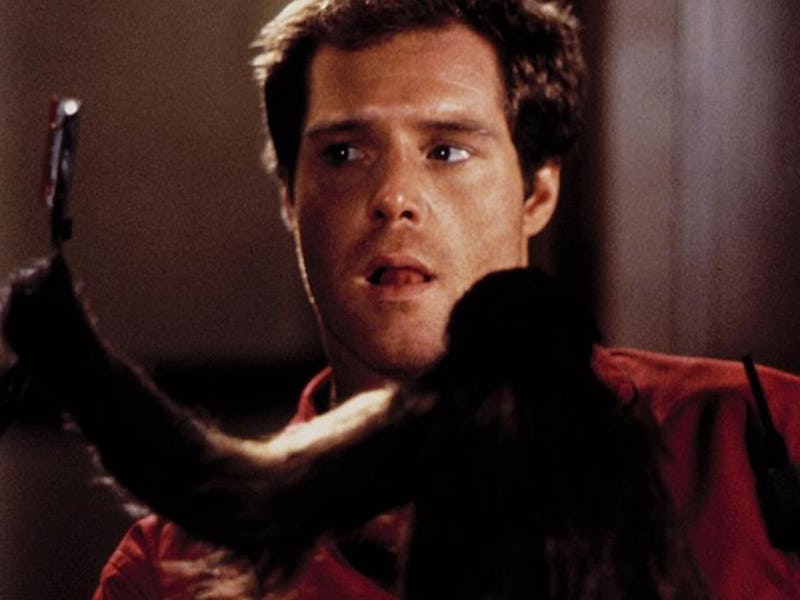You need to watch the most underrated sci-fi thriller on HBO Max ASAP
Look beyond zombies to find an essential George A. Romero film.

What’s the first thing that comes to mind when you hear the name George A. Romero?
If you said zombies that’s entirely expected and understandable. After all, Romero created the modern zombie and an entire subgenre along with it. If you said pointed social and political allegories, often explored through horror, you’d be right as well. From The Crazies (1973) to Land of the Dead (2005), Romero always provided a unique lens into the human condition.
But in 1988 he directed his first studio feature, a film considered to be something of an outlier in his filmography. But upon closer inspection, this cult classic is distinctly Romero.
Based on Michael Stewart’s 1983 novel of the same name, Monkey Shines (1988) — also billed with the fantastic subtitle Monkey Shines: An Experiment in Fear — was also something of an experiment for Romero. It was one of his largest budget features at the time, and his first time working outside of the independent film world where he made his name. Oh, and there was also the fact that he was working with live monkeys on set.
Monkey Shines ended up being the longest moviemaking process of Romero’s career. After all that, it flopped at the box office and earned a shrug from critics. But more recently, the film received a much-deserved reappraisal from horror fans.
Monkey Shines centers on Allan Mann (Jason Beghe), a recent quadriplegic struggling to adjust to a wheelchair after his promising career as a law student and athlete is ripped away. His overbearing mother (Joyce Van Patten) and nurse (Christine Forrest) make this transition even harder. Allan is in a dark place until his friend, scientist Geoffrey Fisher (John Pankow), gifts him with a helper monkey named Ella.
What Allan doesn’t know is that Ella isn’t an ordinary helper monkey. Geoffrey has been injecting her with an experimental serum comprised of human brain tissue. Yes, even when they’re not being devoured, Romero couldn’t get enough of “braaains.” (Fun fact: Zombies eating brains wasn’t a Romero concept. It was added to the mythology of zombies in Dan O’Bannon’s 1985 film The Return of the Living Dead.)
Ella and Allan develop a strong bond, one that manifests as a telepathic connection. His will becomes her doing, and his negative emotions start to have deadly consequences. First, that causes Ella to go after the pet bird owned by Allan’s cruel nurse. Later, the monkey attacks the surgeon who misdiagnosed Allan’s paralysis (played by a young Stanley Tucci).
Allan also grows close to Ella’s trainer Melanie (Kate McNeil), which creates feelings of jealousy in Ella. The monkey becomes increasingly controlling, feeding off of Allan’s dark, subconscious, impulses, and muddying the waters between man and animal until Allan’s negative feelings towards himself are turned against him in the form of a monkey he no longer finds helpful. (If this is starting to sound familiar, it might be because the film went on to inspire episodes of both The Simpsons and Malcolm in the Middle, among others.)
At its core, Monkey Shines is a love story between man and beast, King Kong writ in miniature. Allan and Ella are unified, parallel creatures, suggested by the two Ls in both of their names. And despite Allan’s status as man (or Mann), evolution is not enough to fully disconnect man and ape. Romero concerns himself with the baser instincts of mankind, perhaps suggesting that in the dark and isolated recesses of our mind, something primitive still lurks. It’s these themes that Romero would explore again and again in his zombie films, and throughout his filmography in films including Martin (1977), The Dark Half (1993), and Bruiser (2000).
Monkey Shines may not be as flashy or influential as some of Romero’s better-known works, but it isn’t a lesser entry in Romero’s filmography. Instead, it’s an essential part of the Romero canon. And while it most likely isn’t the first thing anyone thinks of when they hear George A. Romero — and is devoid of any zombies — Monkey Shines is uniquely concerned with the human condition and the animalistic side of human nature.
Oh, and it boasts one of the best taglines of all time: “Once there was a man whose prison was a chair. The man had a monkey, they made the strangest pair. The monkey rules the man, it climbed inside his head. And now as fate would have it, one of them is dead.”
Pure poetry, no monkey business.
MONKEY SHINES IS STREAMING NOW ON HBO MAX IN THE U.S.
This article was originally published on